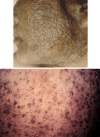Role of AhR/ARNT system in skin homeostasis
- PMID: 24966027
- PMCID: PMC4220966
- DOI: 10.1007/s00403-014-1481-7
Role of AhR/ARNT system in skin homeostasis
Abstract
Aryl hydrocarbon receptor (AhR) is a ligand-dependent transcription factor that binds to structurally diverse synthetic and naturally occurring chemicals including dioxins, flavonoids, tryptophan photoproducts, and Malassezia metabolites. Upon binding to its ligands, cytoplasmic AhR translocates to the nucleus, heterodimerizes with aryl hydrocarbon receptor nuclear translocator (ARNT), and mediates numerous biological and toxicological effects by inducing the transcription of various AhR-responsive genes. AhR ligation controls oxidation/antioxidation, epidermal barrier function, photo-induced response, melanogenesis, and innate immunity. This review summarizes recent advances in the understanding of the regulatory mechanisms of skin homeostasis mediated by the AhR/ARNT system.
Figures




Similar articles
-
Aryl Hydrocarbon Receptor in Atopic Dermatitis and Psoriasis.Int J Mol Sci. 2019 Oct 31;20(21):5424. doi: 10.3390/ijms20215424. Int J Mol Sci. 2019. PMID: 31683543 Free PMC article. Review.
-
Gene regulation of filaggrin and other skin barrier proteins via aryl hydrocarbon receptor.J Dermatol Sci. 2015 Nov;80(2):83-8. doi: 10.1016/j.jdermsci.2015.07.011. Epub 2015 Jul 26. J Dermatol Sci. 2015. PMID: 26276439 Review.
-
Aryl hydrocarbon receptor and aryl hydrocarbon nuclear translocator expression in human and rat placentas and transcription activity in human trophoblast cultures.Toxicol Sci. 2011 Sep;123(1):26-36. doi: 10.1093/toxsci/kfr150. Epub 2011 Jun 10. Toxicol Sci. 2011. PMID: 21666223
-
Functions of the aryl hydrocarbon receptor in the skin.Semin Immunopathol. 2013 Nov;35(6):677-91. doi: 10.1007/s00281-013-0394-4. Epub 2013 Aug 16. Semin Immunopathol. 2013. PMID: 23949496 Review.
-
Hypoxia perturbs aryl hydrocarbon receptor signaling and CYP1A1 expression induced by PCB 126 in human skin and liver-derived cell lines.Toxicol Appl Pharmacol. 2014 Feb 1;274(3):408-16. doi: 10.1016/j.taap.2013.12.002. Epub 2013 Dec 16. Toxicol Appl Pharmacol. 2014. PMID: 24355420 Free PMC article.
Cited by
-
Impact of airborne particulate matter on skin: a systematic review from epidemiology to in vitro studies.Part Fibre Toxicol. 2020 Jul 25;17(1):35. doi: 10.1186/s12989-020-00366-y. Part Fibre Toxicol. 2020. PMID: 32711561 Free PMC article.
-
A Rose Extract Protects the Skin against Stress Mediators: A Potential Role of Olfactory Receptors.Molecules. 2020 Oct 16;25(20):4743. doi: 10.3390/molecules25204743. Molecules. 2020. PMID: 33081083 Free PMC article.
-
The UVR Filter Octinoxate Modulates Aryl Hydrocarbon Receptor Signaling in Keratinocytes via Inhibition of CYP1A1 and CYP1B1.Toxicol Sci. 2020 Sep 1;177(1):188-201. doi: 10.1093/toxsci/kfaa091. Toxicol Sci. 2020. PMID: 32603427 Free PMC article.
-
The role of aryl hydrocarbon receptor in vitiligo: a review.Front Immunol. 2024 Feb 1;15:1291556. doi: 10.3389/fimmu.2024.1291556. eCollection 2024. Front Immunol. 2024. PMID: 38361944 Free PMC article. Review.
-
Aryl Hydrocarbon Receptor in Atopic Dermatitis and Psoriasis.Int J Mol Sci. 2019 Oct 31;20(21):5424. doi: 10.3390/ijms20215424. Int J Mol Sci. 2019. PMID: 31683543 Free PMC article. Review.
References
-
- Agostinis P, Garmyn M, Van Laethem A. The aryl hydrocarbon receptor: an illuminating effector of the UVB response. Sci STKE. 2007;403:pe49. - PubMed
-
- Akiyama T, Seishima M, Watanabe H, Nakatani A, Mori S, Kitajima Y. The relationships of onset and exacerbation of pustulosis palmaris et plantaris to smoking and focal infections. J Dermatol. 1995;22(12):930–934. - PubMed
-
- Caputo R, Monti M, Ermacora E, Carminati G, Gelmetti C, Gianotti R, Gianni E, Puccinelli V. Cutaneous manifestations of tetrachlorodibenzo-p-dioxin in children and adolescents. Follow-up 10 years after the Seveso, Italy, accident. J Am Acad Dermatol. 1988;19(5 Pt. 1):812–819. doi: 10.1016/S0190-9622(88)70238-8. - DOI - PubMed
-
- Connor KT, Harris MA, Edwards MR, Budinsky RA, Clark GC, Chu AC, Finley BL, Rowlands JC. AH receptor agonist activity in human blood measured with a cell-based bioassay: evidence for naturally occurring AH receptor ligands in vivo. J Expo Sci Environ Epidemiol. 2008;18(4):369–380. doi: 10.1038/sj.jes.7500607. - DOI - PubMed
Related articles recently published in Archives of Dermatological Research (selected by the journal’s editorial staff)
Publication types
MeSH terms
Substances
LinkOut - more resources
Full Text Sources
Other Literature Sources
Medical

